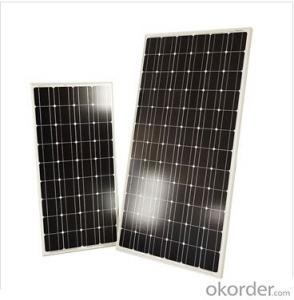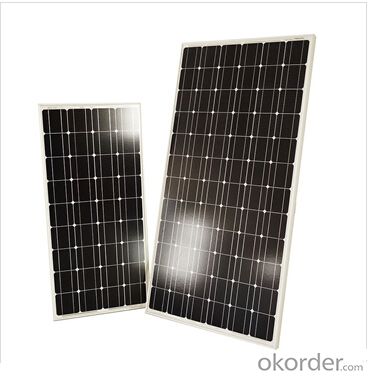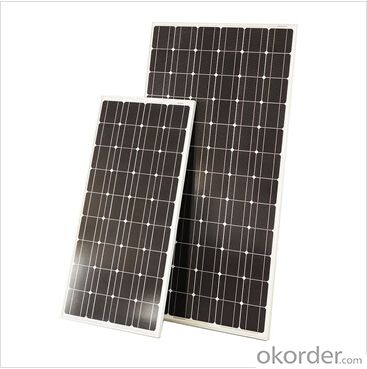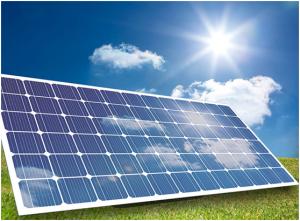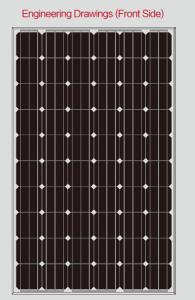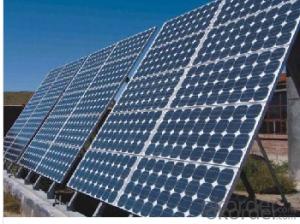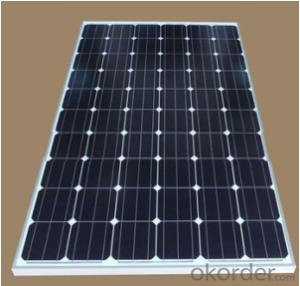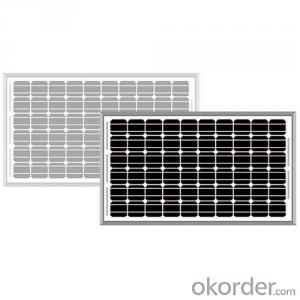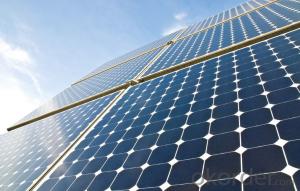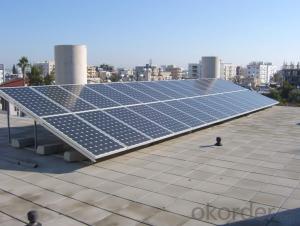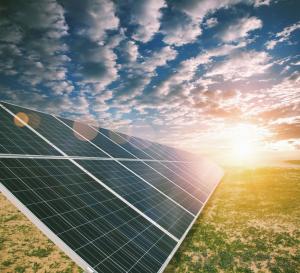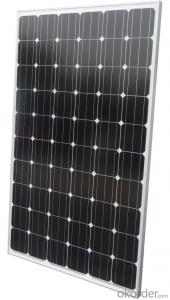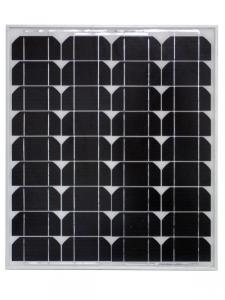Mirrored Solar Monocrystalline Series Panels 255W
- Loading Port:
- Shanghai
- Payment Terms:
- TT OR LC
- Min Order Qty:
- 100 pc
- Supply Capability:
- 50000 pc/month
OKorder Service Pledge
OKorder Financial Service
You Might Also Like
Introduction of Solar Monocrystalline Series Panels
CNBM Solar photovoltaic (PV) Panel is designed for large electrical power requirements. It is the optimal choice for both on-grid and off-grid power systems. CNBM Solar panel offers high performance of power per square foot of solar array. Monocrystalline silicon(c-Si): often made using the Czochralski process. Single-crystal wafer cells tend to be expensive, and because they are cut from cylindrical ingots, do not completely cover a square solar cell module without a substantial waste of refined silicon. Hence most c-Si panels have uncovered gaps at the four corners of the cells.
Characteristics of Solar Monocrystalline Series Panels
I Solar Cell : High efficiency crystalline solar cell. Even if under the weak light, the solar module can produce maximum power output.
II Tempered glass (toughened glass): Anti-reflecting coating and high transmission rate glass increase the power output and mechanical strength of solar module.
III EVA and TPT: Using high quality EVA and TPT to prevent destroying and water.
IV AI frame: Without screw, corner connection. 6 holes on the frame can be installed easily.
V Junction box: Multi function junction box with water proof.
VI Long lifetime: ≥25 years; Less power decrease
VII Good performance of preventing from atrocious weather such as wind and hails.
VIII Resisting moisture and etching effectively, not effected by geology.
Standard Test Conditions of Solar Monocrystalline Series Panels
The opto-electrical specifications shown below are stabilized values being measured at Standard Test Conditions, Irradiance: 1000W/m2, Spectrum: AM1.5 at 25°C, The info below is subject to manufacturing tolerances. Where appropriate minutes of measurement are available and are used for the dimensioning of the installation.
Advantages of Solar Monocrystalline Series Panels
• CNBM Solar performance guarantees for 25 years
• 12 years guarantee for workmanship
• Timeliness of delivery
CNBM International Corporation's products including Monocrystalline Solar Panel, Polycrystalline Solar Panel have received and enjoyed famous reputation in many countries and regions in the world .As a solar panel supplier in China, we strive to provide our customers with excellent service, superior products and unmatched value.
Part Number | GSPV255M |
Related Maximum Power(Pmax) | 255W |
Current at Pmax(Imp) | 8.36A |
Voltage at Pmax(Vmp) | 30.5V |
Short-Circuit Current(Isc) | 8.82A |
Open-Circuit Voltage(Voc) | 37.3V |
Module Dimension | 1640*992*40mm |
Cel Type | 156*156mm Mono-crystalline |
Cell configuration | 60 (6*10)PCS in series |
Weight | 18kg |
Cables | 4.0mm², Length: 900mm |
Guarantee Solar Monocrystalline Series Panels
Products Guarantee | 10 yrs free from defects in materials and workmanship |
Performance Guarantee | No less than 90% within 10yrs and no less than 80% within 25yrs |
Certificates | IEC, ISO, TUV, CE |
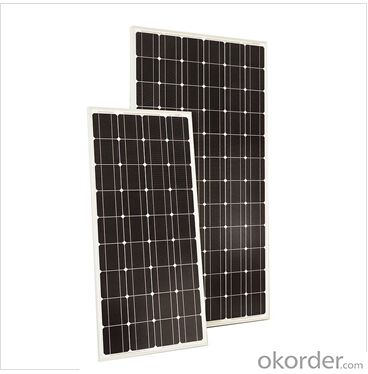
FAQ
We have organized several common questions for our clients,may help you sincerely:
1.What’s price per watt?
A: It’s depends on the quantity, delivery date and payment terms of the order. We can talk further about the detail price issue. Our products is high quality with lower price level.
2.Can you tell me the parameter of your solar panels?
We have different series of cells with different power output, both from c-si to a-si. Please take our specification sheet for your reference.
3.How do you pack your products?
We have rich experience on how to pack the panels to make sure the safety on shipment when it arrives at the destination.
4.Can you do OEM for us?
Yes, we can.
5.How long can we receive the product after purchase?
In the purchase of product within three working days, We will arrange the factory delivery as soon as possible. The perfect time of receiving is related to the state and position of customers. Commonly 7 to 10 working days can be served.
- Q: I am doing a project on solar energy at the moment and I was just wondering how.
- Sunlight okorder /
- Q: I know absolutely nothing about electronics but have a lot of money. I am thinking of buying the Sunforce 3730 30W monocrystalline solar panel (the best I could find that was that size or smaller). What would be a good battery to go with it? I am thinking of buying a 2V Concorde Sun Xtender (again, the best I could find). But how many batteries will I need? I want enough batteries that it would take the solar panel 2 days to completely charge them from empty (bearing in mind the unavoidable inefficiencies like cloudiness/changing sun angles). Also, what other stuff would I need, like I hear something about a quot;charge controllerquot;? Any suggestions would be appreciated.
- If you are at a location/time where the panel will put out less power, you can adjust the battery size accordingly. And running a battery to empty is very bad for it's service life, so it's better to go a bit bigger.
- Q: What Are Solar Panels Made Of?
- Silicon, simular to aluminum foil. When assembled correctly will produce electricity. This is a prosition process to construct. Check out DIY sites on the internet. I hope this was helpful?
- Q: Can solar panels be installed in a community or neighborhood?
- Yes, solar panels can definitely be installed in a community or neighborhood. In fact, installing solar panels at a community or neighborhood level can have several benefits. It allows for a more cost-effective approach, as the installation and maintenance expenses can be shared among multiple households. Moreover, it promotes a more sustainable and environmentally friendly energy source, reducing reliance on fossil fuels and lowering carbon emissions. Additionally, community solar projects encourage collaboration and community engagement, fostering a sense of unity and shared responsibility towards a greener future.
- Q: I want to get a solar panel to run a fan (or two) for swamp coolers.I'm not looking to power 20box fans, just maybe some of those auto fans.What the heck kind of panel do I need? What is a power inverter and what does it do?Will I lose all my power if I use a 00' extension cord?How do I choose what I'm going to need?
- Here is one that can work for a small swamp cooler, but if you want to build a larger one, use multiple fans. This model uses .4 amps at 2 volts DC. 2 X .4 = 5 watts. You'll want about 6 watts per fan for the panel, so if you had 4 of these fans, at 5 watts each, look for a 25 watt or so sized panel. The panel should have a Volts Open Circuit (Voc) rating around 8 volts, that is normal for a 2 volt system. Then you can just wire the fans, in parallel to each other, to the output of the panel. I read an article in Home Power Magazine about a guy who did this to ventilate his crawl space. He only wanted the fans to run when it was dry weather outside, like when it's sunny. The panel not only powered the fans, but were perfect for sensing when it was sunny. You can do the same thing with the swamp cooler. This fan was clipped from Marlin Jones website, they sell small electronics and such, the link is below. They do not sell solar panels, but I've found OKorder to be a great source for them. We have two small arrays here that run LED lights in parts of our home, and charge cell phones, ipods and small electronics. Take care Jorge, Rudydoo
- Q: Can solar panels be installed on water bodies or reservoirs?
- Yes, solar panels can be installed on water bodies or reservoirs. This is known as a floating solar power plant or floating photovoltaic system. It involves placing solar panels on floating platforms that are anchored to the bottom of the water body or reservoir. This innovative approach allows for the utilization of otherwise unused space, reduces evaporation, and provides cooling benefits to the solar panels, increasing their efficiency.
- Q: How much energy can a solar panel produce?
- The amount of energy a solar panel can produce depends on several factors, including its size, efficiency, and location. On average, a residential solar panel system can generate anywhere from 10 to 20 kilowatt-hours (kWh) of electricity per square meter per day. However, this can vary significantly based on sunlight availability, panel orientation, and weather conditions.
- Q: Our school is in the process of being built, but they have no plans to include any environmental benefits. I was wondering how to get a grant for solar panels (at least) or who I can talk to in order to get a grant.
- Excessively long payback schemes for solar panels are being quoted. It depends on where you live, where you situate your solar panels, what you buy and if you get a grant or install them yourself. Much of the cost of Solar panels is in the installation. Any competent DIY person can install a simple solar panel system. Ours cost less than ?000 to buy and self install. What are you calling payback time? Because each time I don't use fossil fuels and use solar energy instead, I don't get a 'fossil fuel' bill. Whilst we still use some electricity for running a fridge, lighting etc we have no other fuel bills, no gas, no oil, no electric heating no electrically heated hot water. We have woodburning stoves (which run on free wood) and solar. Remember you are not just paying for the electricity/gas/oil etc that you use, you are also paying standing charges, VAT etc. Include those in your 'payback time figures' and you will see a very different picture. How long would it take you to pay back ?,000 if you only had one tiny electric bill each quarter?
- Q: why don't we take a cue from mother nature and make our soar panels like trees? thousands of leaves or needle (like a pine tree) instead of one big flat panel? I mean it seems to work pretty good for all the plants i see why would it not work for us. It would be aesthetically pleasing and with the right engineering wouldn't it make them not have to worry about tracking the sun? i already have some ideas about the process of making them just no available labratory.
- Because we and the trees are trying to solve a different problem. We want electricity, a tree wants light (and some heat) for photosynthesis. In getting the electricity we use Silicon for solar panels. (Sometimes Gallium Arsenide). And we exploit the same thing in Silicon that allows them to be computer chips. The fact that they conduct differently when voltage is applied. But for a solar panel that is done essentially in reverse. We GET a voltage difference (electricity) from shoving energy through it. Look up junction bias on google or yahoo for explanation. But the DESIGN problem is: You have to couple these panels together the right way - according to their bias. You can't string them up willy nilly. There is a pattern. And when one breaks in this pattern. (I mean when the actual panel cracks, which they do easily as they are brittle). It can change the overall bias. This can make even be worse than if it was removed, it can actually fight against the working ones. The efficiency is there in arranging them like a tree, but the practicality of maintenance would be daunting.
- Q: Are there any noise or sound-related issues with solar panels?
- No, solar panels do not produce any noise or sound-related issues as they operate silently.
Send your message to us
Mirrored Solar Monocrystalline Series Panels 255W
- Loading Port:
- Shanghai
- Payment Terms:
- TT OR LC
- Min Order Qty:
- 100 pc
- Supply Capability:
- 50000 pc/month
OKorder Service Pledge
OKorder Financial Service
Similar products
Hot products
Hot Searches
Related keywords
